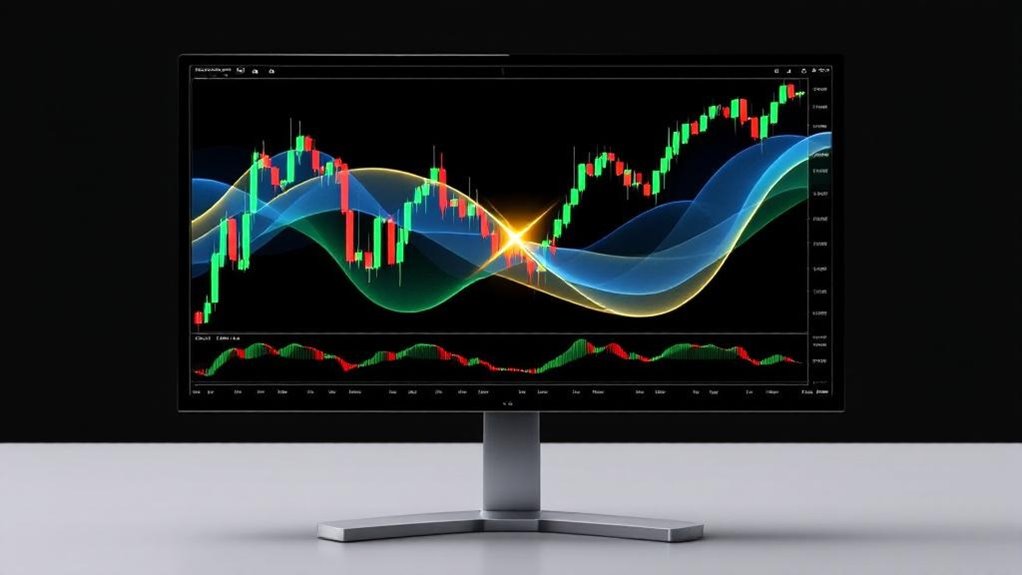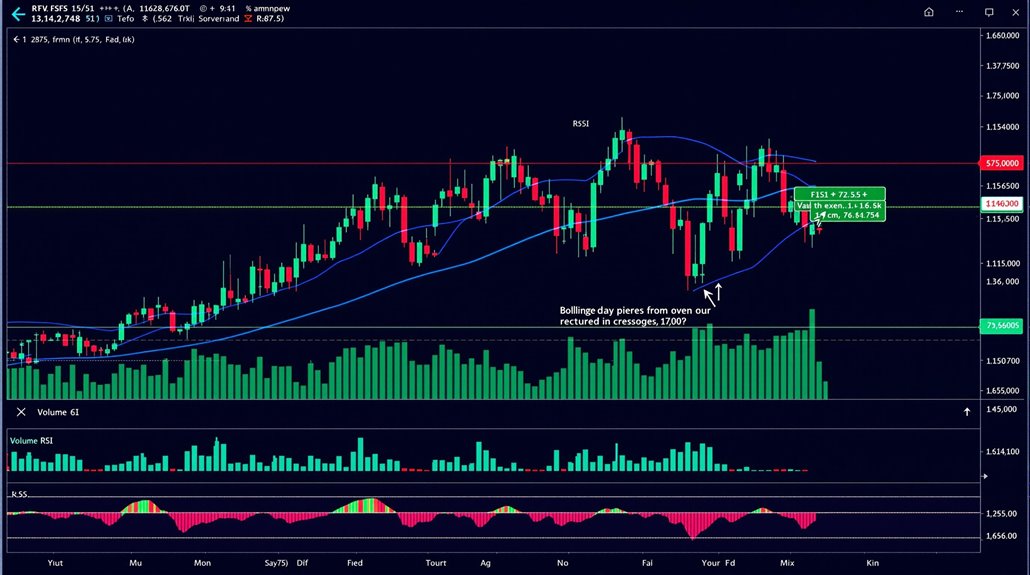Bollinger Bands utilize statistical volatility measurements through a three-line system combining a 20-day simple moving average with upper and lower bands set at two standard deviations. Advanced traders implement breakout strategies by validating band penetrations with volume analysis, while employing the Bollinger Band Squeeze to identify potential breakouts during low volatility periods. Professional traders enhance their technical analysis by integrating momentum indicators and implementing precise stop-loss protocols, creating an extensive framework for identifying high-probability trading opportunities that rewards deeper technical understanding.
Key Takeaways
- The Bollinger Band Squeeze strategy identifies potential breakouts during low volatility periods, signaling imminent price movements with statistical significance.
- Validate breakouts through decisive candle closes beyond the bands, with volume exceeding twice the 20-period moving average.
- Double Bottom Patterns below the Lower Band indicate seller exhaustion, while subsequent bottoms above signal buyer accumulation.
- Implement trailing stops along the middle band during trending phases, adjusting band deviation to 2.1-2.2 during volatile markets.
- Combine price persistence along bands with expanding volume to confirm trend strength, using RSI to filter overbought/oversold conditions.
Understanding the Core Mechanics of Bollinger Bands

While many technical analysis tools offer singular insights into market behavior, Bollinger Bands provide traders with a thorough framework for analyzing both price trends and volatility through their sophisticated three-line construction.
The fundamental Bollinger Band basics consist of three critical components working in harmonious conjunction: a 20-day simple moving average serving as the middle band, complemented by upper and lower bands positioned at two standard deviations from this central line.
Through historical price analysis, these bands dynamically adjust their width based on market volatility, creating a responsive envelope around price action. This versatile indicator has proven effective across all time frames, making it invaluable for both day traders and long-term investors.
The mathematical precision underlying this technical indicator emerges through its standardized calculation method: the upper band equals the SMA plus two standard deviations, while the lower band represents the SMA minus two standard deviations.
This systematic approach enables traders to quantify market volatility and identify potential price extremes with statistical significance.
Mastering Breakout Trading With Bollinger Bands
Successful Bollinger Band breakout trading requires practitioners to distinguish legitimate breakout signals from false movements through rigorous validation protocols.
Trading volume serves as a critical confirmatory indicator, with substantial increases in volume accompanying price penetration of the bands typically signaling higher-probability breakout opportunities. Volume-price divergence analysis provides additional confirmation of trend strength and potential reversals. During periods of low volatility, traders can identify potential breakouts using the Bollinger Band Squeeze strategy.
The strategic placement of stop-loss orders below the lower band for long positions and above the upper band for short positions establishes a methodical risk management framework essential for preserving capital during inevitable false breakouts.
Identifying Valid Breakout Signals
Trading breakouts with Bollinger Bands demands a systematic approach to signal validation through multiple confirmation criteria.
Understanding squeeze dynamics and breakout psychology requires traders to analyze band contraction periods and subsequent momentum shifts with precision. The strategy relies on the fundamental principle that standard deviations determine the bands’ positioning around the middle line. Similar to the signal line crossings in MACD analysis, these band breaches require careful validation to confirm genuine trading opportunities.
- Validate breakouts through decisive candle closes beyond the bands, with particular emphasis on full-body closes rather than minor breaches or wicks.
- Confirm signals by aligning breakouts with established support and resistance levels, increasing probability through structural validation.
- Filter potential false signals using momentum indicators such as RSI, MACD, or stochastic oscillators to verify trend direction and strength.
Implementing strict risk management protocols becomes essential, with stop-loss placement just inside the bands and profit targets established at previous swing points or predetermined risk-reward ratios.
Volume-Based Breakout Confirmation
Beyond conventional price analysis, mastering Bollinger Band breakouts requires the integration of volume-based confirmation techniques to validate genuine market moves and filter out potential false signals.
Volume analysis serves as a critical filter, with authentic breakouts typically accompanied by volume levels exceeding twice the 20-period moving average.
Empirical evidence demonstrates that breakout validation through volume metrics markedly enhances trading performance by reducing false signals and improving risk-adjusted returns.
When price penetrates either the upper or lower Bollinger Band with corresponding volume surge, traders gain additional confirmation of institutional participation and broader market conviction.
This dual confirmation approach proves most effective in liquid markets where volume data maintains reliability, though traders must calibrate parameters according to their specific asset class and timeframe.
Maintaining a strict risk-reward ratio for each breakout trade helps optimize position sizing and prevent overexposure to any single position.
During periods of band width expansion, traders should exercise additional caution as increased volatility can generate more frequent but potentially unreliable breakout signals.
Stop Loss Placement Rules
Precise stop loss placement serves as a cornerstone of effective Bollinger Band breakout trading, with empirically validated rules governing ideal exit points relative to band positions and market volatility conditions.
The implementation of systematic stop loss strategies requires careful volatility adjustment to maintain prime risk parameters. Statistical bands serve as key reference points for determining optimal stop placement during trend phases. Combining moving averages with crossover signals helps validate stop loss decisions in trending markets.
- Short-trade stops are positioned 1-2% above the upper band following downside breaks, while long-trade stops utilize the lower band’s dynamic support properties.
- Volatile market phases demand wider stop placement through band deviation adjustments of 2.1-2.2 standard deviations.
- Trailing stops dynamically follow the middle band (20-period moving average) during trending phases, allowing profits to run while protecting against reversals.
These technical parameters create a robust framework for managing risk exposure while capitalizing on sustained price movements beyond the bands.
Double Bottom Patterns and Price Reversal Signals
Recognizing double bottom patterns within the context of Bollinger Bands provides traders with a sophisticated methodology for identifying potential price reversals in financial markets. The double bottom psychology manifests through consecutive price rejections at support levels, while the reversal pattern significance becomes particularly notable when confirmed by volume expansion and Bollinger Band dynamics. Using Line On Close charts enables clearer pattern identification by eliminating noise from intraday price fluctuations. Psychological round numbers often serve as critical support zones where double bottoms tend to form with higher frequency.
| Pattern Component | Technical Criteria | Psychological Impact |
|---|---|---|
| First Bottom | Below Lower Band | Initial Seller Exhaustion |
| Second Bottom | At/Above Lower Band | Buyer Accumulation |
| Neckline Break | Volume Expansion | Momentum Confirmation |
Statistical analysis demonstrates enhanced reliability when double bottoms form during established downtrends, with asymmetrical formations often producing more robust reversals due to induced short-covering. The integration of Bollinger Bands provides quantifiable parameters for pattern validation, particularly when the second low demonstrates resilience above the lower band, indicating diminishing selling pressure and potential trend reversal.
Advanced Band Walking Techniques for Trend Trading

Sophisticated band walking techniques represent one of the most powerful applications of Bollinger Bands for capturing sustained trending movements in financial markets. The systematic analysis of price action relative to the bands provides traders with robust trend confirmation signals when properly executed.
- Price persistence along either the upper or lower band, accompanied by expanding volume and strong momentum indicators, validates the prevailing trend’s strength. When trading during strong trends, remember that tags of bands alone do not automatically generate reliable buy or sell signals.
- Multiple consecutive closes outside the bands, particularly when supported by increasing trading volume, signal potential trend continuation rather than imminent reversal. The disciplined approach of letting profits run while quickly cutting losses helps maximize returns during strong trending periods.
- Precise entry timing during band walking phases requires confluence between price action, volume expansion, and secondary technical indicators.
Professional traders leverage these advanced band walking techniques by implementing systematic stop-loss placement outside consolidation zones while managing position sizing relative to volatility conditions.
The methodology demands rigorous attention to exhaustion signals, including bearish engulfing patterns and momentum divergences, to maintain tactical advantage throughout trending periods.
Capitalizing on the Bollinger Band Squeeze
The Bollinger Band Squeeze represents one of the most potent technical analysis patterns for identifying imminent breakout opportunities in financial markets. This distinctive configuration emerges when volatility indicators contract considerably, with the bands tightening around price action in a manner that historically precedes substantial directional moves.
Traders can optimize their approach to squeeze dynamics by implementing an extensive strategy that combines multiple confirmation signals. The appearance of a squeeze during a six-month volatility low often signals an impending price movement. When price action demonstrates compression between the upper and lower bands, practitioners should monitor complementary technical indicators such as RSI, MACD, and volume patterns to validate potential breakout signals. The identification of divergence patterns can provide additional confirmation of potential trend reversals during squeeze conditions.
Risk management remains paramount during squeeze conditions, with successful traders establishing precise entry points and predetermined stop-loss levels. The most effective execution typically involves waiting for a decisive candle close beyond the compressed bands, accompanied by increased volume and momentum confirmation, rather than reacting to minor band penetrations that may represent false signals.
Optimizing Trade Entries With Multiple Indicators

Successful implementation of Bollinger Band trading strategies requires a thorough approach that integrates multiple technical indicators to validate entry signals and minimize false breakouts. The synergy between various technical tools enhances trade psychology and decision-making confidence.
- Volume analysis serves as a primary confirmation tool, with significant spikes validating breakout signals and institutional participation, particularly in liquid markets where large players drive directional moves. Understanding momentum oscillator patterns can provide additional confirmation for potential price movements.
- RSI integration filters overbought and oversold conditions while identifying potential reversals through divergence analysis, as demonstrated in Linda Raschke’s “Holy Grail” methodology. The 20-day simple moving average serves as a crucial baseline for measuring price action and determining trend direction.
- Multiple time frame analysis, combined with trend indicators like Super Trend, provides an extensive framework for identifying high-probability setups while filtering market noise.
The indicator synergy approach transforms isolated signals into robust trading opportunities by requiring confirmation across multiple technical dimensions. This systematic methodology helps traders maintain disciplined execution while reducing emotional decision-making during volatile market conditions.
Frequently Asked Questions
How Do Bollinger Bands Perform in Different Market Sectors and Commodities?
Bollinger Bands exhibit varying effectiveness across different market sectors and commodities, with distinct performance characteristics:
- Banking and FMCG sectors show reliable signals during stable periods due to consistent volatility profiles.
- Energy and commodity markets demonstrate strong predictive value during squeeze-breakout scenarios.
- Cryptocurrency markets require wider standard deviation settings to accommodate heightened volatility.
- Agricultural commodities respond effectively during low liquidity periods but require careful signal validation during seasonal volatility.
Can Bollinger Bands Be Effectively Combined With Elliott Wave Analysis?
The synergy between Elliott Wave Patterns and Bollinger Band Signals creates a powerful analytical framework for market timing.
When price action consistently touches the upper band during uptrends, it often confirms impulsive Elliott waves (1,3,5), while lower band interactions validate corrective waves (2,4).
The combination provides traders with enhanced precision in identifying wave completion points and potential reversals, particularly during complex market corrections.
This integration delivers superior trend validation and entry/exit timing across multiple timeframes.
What’s the Optimal Timeframe Adjustment for Bollinger Bands During High Volatility?
During high volatility periods, ideal timeframe adjustments typically involve reducing standard intervals to capture short term adjustments more effectively.
Market participants often shift from higher timeframes (1-hour, 4-hour) to shorter durations (5-minute, 15-minute) when volatility spikes occur.
This adaptation enables traders to:
- Respond more rapidly to price movements
- Identify potential reversal points earlier
- Reduce lag in technical signals
- Better manage risk during turbulent market conditions
How Do Earnings Announcements Affect Bollinger Band Reliability and Trading Signals?
Earnings announcements greatly diminish trading signal reliability due to sudden volatility spikes that distort normal price patterns.
Statistical evidence shows mean-reversion strategies‘ returns dropping from 2.15% during non-earnings periods to just 0.54% during earnings windows.
These fundamental catalysts introduce unpredictable price movements that overwhelm technical indicators, leading to increased false signals and whipsaw trades.
Traders should exercise heightened caution when implementing strategies around corporate earnings events.
Should Bollinger Band Settings Be Modified for Cryptocurrency Markets?
“One size doesn’t fit all” rings especially true when considering Bollinger Band adjustments for cryptocurrency markets.
The heightened cryptocurrency volatility necessitates modifications to traditional settings, typically requiring wider standard deviation bands (2.5-3x) and shorter moving average periods (10-14 periods).
These adaptations help filter out market noise and reduce false signals that commonly occur with default parameters, ultimately providing traders more reliable indicators for entry and exit points in the volatile crypto environment.
Conclusion
Mastering Bollinger Bands requires disciplined study and consistent application of its core principles. As the old adage suggests, “The trend is your friend,” but traders must integrate multiple technical aspects, from squeeze patterns to breakout confirmations, to maximize their effectiveness. When properly implemented alongside complementary indicators, Bollinger Bands serve as a powerful analytical framework for identifying high-probability trading opportunities across various market conditions.
References
- https://www.youtube.com/watch?v=Jn3P-SSCiRU
- https://hmarkets.com/learn-to-trade/learning-hub/bollinger-bands/
- https://blog.elearnmarkets.com/trading-strategies-with-bollinger-bands/
- https://www.fxacademy.com/learn/advanced-sr-trend-lines/sr-trend-lines-bollinger-bands
- https://tradefundrr.com/bollinger-bands-trading-tips/
- https://www.britannica.com/money/bollinger-bands-indicator
- https://www.investopedia.com/terms/b/bollingerbands.asp
- https://blog.quantinsti.com/bollinger-bands/
- https://thetradinganalyst.com/how-to-use-bollinger-bands-for-day-trading/
- https://b2broker.com/ja/library/what-are-the-bollinger-bands-bb-in-technical-analysis/

